Chapter 05 States of Matter
Multiple Choice Questions (MCQs)
1. A person living in Shimla observed that cooking food without using pressure cooker takes more time. The reason for this observation is that at high altitude
(a) pressure increases
(b) temperature decreases
(c) pressure decreases
(d) temperature increases
Answer (c) Pressure at the top of a mountain [or at high altitude] is low. This suggests that boiling takes place at lower temperature, due to which things take more time to boil. However, in a pressure cooker, pressure is increased and hence, boiling point increases. Thus, things comes to boil in a pressure cooker in a less period of time.Show Answer
(a) Viscosity
(b) Surface tension
(c) Critical phenomena
(d) Pressure
Answer (b) The spherical shape of rain droplets is due to surface tension. The lowest energy state of a liquid will be when the surface area is minimum. Surface tension tries to decrease the surface area of the liquid to the minimum. The rain droplets are spherical because for a given volume, a sphere has minimum surface area.Show Answer
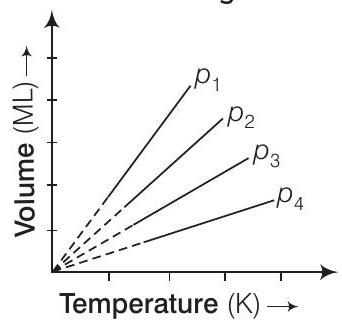
(a) $p_{1}>p_{2}>p_{3}>p_{4}$
(b) $p_{1}=p_{2}=p_{3}=p_{4}$
(c) $p_{1}<p_{2}<p_{3}<p_{4}$
(d) $p_{1}<p_{2}=p_{3}<p_{4}$
Thinking Process The question is based upon Boyle’s law. It states that at constant temperature, the volume of a given proportional to its pressure. i.e., $V \propto \frac{1}{p}$ or, $p V=$ constant Answer (c) At a particular temperature, $p V=$ constant $$
\begin{aligned}
Thus, \quad p_{1} V_{1} & =p_{2} V_{2}=p_{3} V_{3}=p_{4} V_{4} \\
As \quad V_{1} & >V_{2}>V_{3}>V_{4} \\
Therefore, \quad p_{1} & <p_{2}<p_{3}<p_{4}
\end{aligned}
$$Show Answer
(a) charge of interacting particles
(b) mass of interacting particles
(c) polarisability of interacting particles
(d) strength of permanent dipoles in the particles
Answer (c) London dispersion forces operate only over very short distance. The energy of interaction varies as $\frac{1}{\text { (distance between two interacting particles) }^{6}}$. Large or more complex are the molecules, greater is the magnitude of London forces. This is obviously due to the fact that the large electron clouds are easily distorted or polarised. Hence, greater the polarisability of the interacting particles, greater is the magnitude of the interaction energy.Show Answer
(a) more than unit electronic charge
(b) equal to unit electronic charge
(c) less than unit electronic charge
(d) double the unit electronic charge
Answer (c) Dipole-dipole forces act between the molecules possessing permanent dipole and ends of dipoles possess ‘partial charges’. Partial charges present on ends of a dipole are always less than the unit electronic charge. e.g.,Show Answer
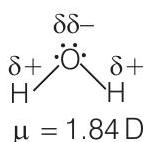
(a) $0.8 \times 10^{5} \mathrm{~atm}$
(b) $0.008 \mathrm{Nm}^{-2}$
(c) $8 \times 10^{4} \mathrm{Nm}^{-2}$
(d) $0.25 \mathrm{~atm}$
Answer (c) Given that, pressure of a $1: 4$ mixture of $H_{2}$ and $O_{2}$ enclosed in a vessel is one atmosphere. This suggests that the moles ratio of $H_{2}$ and $O_{2}$ is $1: 4$. Thus, partial pressure of dioxygen $\left(O_{2}\right)$ is given as $\therefore$ Partial pressure of $O_{2}=$ Mole fraction of $O_{2} \times$ total pressure of mixture $$
\begin{aligned}
& =\frac{4}{1+4} \times 1=\frac{4}{5} \times 1 \mathrm{~atm} \\
& =0.8 \mathrm{~atm}=0.8 \times 10^{5} \mathrm{Nm}^{-2}=8 \times 10^{4} \mathrm{Nm}^{-2}
\end{aligned}
$$Show Answer
(a) Increases
(b) Decreases
(c) Remains same
(d) Becomes half
Thinking Process This problem is based on Gay-Lussac’s law which states that “volume remaining constant, the pressure of a given mass of a gas is directly proportional to its temperature in degrees Kelvin”. Answer (a) As the temperature increases, average kinetic energy of molecules increases. From Gay-Lussac’s law, at constant volume, as the temperature is increased, pressure increases.Show Answer
| Gases | $\mathbf{H}_{\mathbf{2}}$ | $\mathbf{H e}$ | $\mathbf{O}_{\mathbf{2}}$ | $\mathbf{N}_{\mathbf{2}}$ |
|---|---|---|---|---|
| Critical temperature in Kelvin | 33.2 | 5.3 | 154.3 | 126 |
From the above data what would be the order of liquefaction of these gases? Start writing the order from the gas liquefying first
(a) $H_{2}, He, O_{2}, N_{2}$
(b) $He, O_{2}, H_{2}, N_{2}$
(c) $N_{2}, O_{2}, He, H_{2}$
(d) $O_{2}, N_{2}, H_{2}, He$
Answer (d) Higher the critical temperature, more easily is the gas liquified. Hence, order of liquefaction starting with the gas liquefying first will be $O_{2}, N_{2}, H_{2}$, $He$. Note Critical temperature of a gas may be defined as that temperature above which it cannot be liquified howsoever high pressure may be applied on the gas.Show Answer
(a) Pascal
(b) $\mathrm{Nsm}^{-2}$
(c) $\mathrm{km}^{-2} \mathrm{~s}$
(d) $\mathrm{Nm}^{-2}$
Answer (b) The SI unit of viscosity coefficient $(\eta)$ is $\mathrm{Nm}^{-2} \mathrm{~s}$ or $\mathrm{Nsm}^{-2}$. $\begin{array}{rlrl} & \text { As we know that, } & f & =\eta A \frac{d v}{d x} \\ \text { where, } & f =\text { force } \\ \eta & =\text { viscosity coefficient } \\ \frac{d v}{d x} & =\text { velocity gradient }\end{array}$ Substitute SI units of $f=N, d x=m, A=m^{2}$ and $v=m s^{-1}$ in above equation, to get, $$
\eta=\frac{\mathrm{N} \times \mathrm{m}}{\mathrm{m}^{2} \times \mathrm{ms}^{-1}}=\mathrm{Nm}^{-2} \mathrm{~s}
$$ Hence, the si unit of $\eta=$ is $n s m^{-2}$Show Answer
| Cities | Shimla | Bangalore | Delhi | Mumbai |
|---|---|---|---|---|
| $\boldsymbol{p}$ in $\mathbf{N} / \mathbf{m}^{\mathbf{2}}$ | $1.01 \times 10^{5}$ | $1.2 \times 10^{5}$ | $1.02 \times 10^{5}$ | $1.21 \times 10^{5}$ |
Consider the above data and mark the place at which liquid will boil first.
(a) Shimla
(b) Bangalore
(c) Delhi
(d) Mumbai
Thinking Process (i) A liquid boils when vapour pressure above it becomes equal to the atmospheric pressure. Lower the atmospheric pressure, lower is the boiling point. (ii) Arrange the four cities according to the increase of atmospheric pressures and pick out the lowest one. Answer (a) Shimla has the lowest atmospheric pressure among all the four cities. Thus, at Shimla liquid will boil first because lower the atmospheric pressure, lower is the boiling point.Show Answer

(a) Only B
(b) $C$ and $D$
(c) $E$ and $F$
(d) $A$ and $B$
Thinking Process (i) The graph given in the question depend upon the Boyle’s law. (ii) At constant temperature, the graph between $\mathrm{pV}$ vs $\mathrm{p}$ at all pressures will be straight line parallel to $x$-axis for ideal gas. (iii) At constant temperature $p \vee v s p$ plot for real gases is not straight line. Answer (a) For ideal gas $p V=$ constant at all pressures. Therefore, only $B$ represents ideal gas.Show Answer
(a) Increase
(b) No effect
(c) Decrease
(d) No regular pattern will be followed
Answer (c) With increase of temperature, the kinetic energy of the molecules of liquid increases which can overcome the intermolecular forces. Hence, the liquid starts flowing. In other words the viscosity of a liquid decreases with increase in temperature. It has been found that the decrease is about $2 $% per degree rise in temperature.Show Answer
(a) Remains same
(b) Decreases
(c) Increases
(d) No regular pattern is followed
Show Answer
Answer
(b) The surface tension of liquids generally decreases with increase of temperature and becomes zero at the critical temperature. The decrease in surface tension with increase of temperature is obviously due to the fact that with increase of temperature, the kinetic energy of the molecules increases and therefore, the intermolecular attraction decreases.
Note Surface tension of a liquid is defined as the force acting at right angles to the surface along one centimetre length of the surface. Units of surface tension are dyne per $\mathrm{cm}$ (or newtons per metre i.e., $\mathrm{Nm}^{-1}$ in the SI systems).
Multiple Choice Questions (More Than One Options)
14. With regard to the gaseous state of matter which of the following statements are correct?
(a) Complete order of molecules
(b) Complete disorder of molecules
(c) Random motion of molecules
(d) Fixed position of molecules
Answer $(b, c)$ In gaseous state, molecules are in a state of random motion i.e., it is the state in which molecules are disorderly arranged. Gaseous state have higher entropy than the liquid as well as solid.Show Answer
(a) $16 \mathrm{~g}$ of gas
(b) $22.7 \mathrm{~L}$ of gas
(c) $6.022 \times 10^{23}$ dioxygen molecules
(d) $11.2 \mathrm{~L}$ of gas
Answer $(a, b, d)$ It is known that, 1 mole of a gas = gram molecular mass = Avogadro’s number of molecules $=22.4$ Lat STR Thus, 1 mole of $O_{2}$ gas $=32 g$ of $O_2=6.02 \times 10^{23}$ molecules $=22.4 ~L$ of $O_{2}$ at STPShow Answer
(a) Low pressure
(c) Low temperature
(b) High pressure
(d) High temperature
Answer ( $b, c$ ) A gas which obeys the ideal gas equation, $p V=n R T$ under all conditions of temperature and pressure is called an ‘ideal gas’. However, there is no gas which obeys the ideal gas equation under all conditions of temperature and pressure. Hence, the concept of ideal gas is only theoretical or hypothetical. The gases are found to obey the gas laws fairly well when the pressure is low or the temperature is high. Such gases are, therefore, known as ‘real gases’. All gases are real gases. Hence, at high pressure and low temneratıre a real nas deviates most from ideal hehaviour.Show Answer
(a) Decreasing the quantity of water
(b) Adding salt to water
(c) Decreasing the volume of the vessel to one-half
(d) Decreasing the temperature of water
Show Answer
Answer
$(b, d)$
When salt is added, less surface area is available for the water molecules to vaporise because salt molecules occupy the position of water molecules on the surface. Hence, vapour pressure of the water decreases.
Moreover, vapour pressure also decreases with decrease in temperature because kinetic energy of the molecules decrease.
Short Answer Type Questions
18. If $1 \mathrm{~g}$ of each of the following gases are taken at STP, which of the gases will occupy (a) greatest volume and (b) smallest volume?
$$ CO, H_{2} O, CH_{4}, NO $$
Answer From Avogadro’s law, we know that Volume of 1 mole of the gas $=$ graw molecular mass $=22.4 \mathrm{~L}$ at STP Volume occupied by $28 \mathrm{~g} \mathrm{CO}(1 \mathrm{~mol} \mathrm{CO})=22.4 \mathrm{~L}$ at STP $$
\left(\because \text { Molar mass of } C O=12+16=28 \mathrm{~g} \mathrm{~mol}^{-1}\right)
$$ $\therefore \quad$ Volume occupied by $1 \mathrm{~g} \mathrm{CO}=\frac{22.4}{28} \mathrm{~L}$ at STP Similarly, volume occupied by $1 \mathrm{~g} \mathrm{H}_{2} \mathrm{O}=\frac{22.4}{18} \mathrm{~L}$ at STP $$
\left(\because \text { Molar mass of } \mathrm{H}_{2} \mathrm{O}=(2 \times 1)+16=18 \mathrm{~g} \mathrm{~mol}^{-1}\right)
$$ Volume occupied by $1 \mathrm{~g} \mathrm{CH}_{4}=\frac{22.4}{16} \mathrm{~L}$ at STP $$
\left(\because \text { Molar mass of } \mathrm{CH}_{4}=12+(4 \times 1)=16 \mathrm{~g} \mathrm{~mol}^{-1}\right)
$$ Volume occupied by $1 \mathrm{~g} \mathrm{NO}=\frac{22.4}{30} \mathrm{~L}$ at STP $$
\left(\because \text { Molar mass of } \mathrm{NO}=14+16=30 \mathrm{~g} \mathrm{~mol}^{-1}\right)
$$ Thus, $1 \mathrm{~g} \mathrm{CH}_{4}$ will occupy maximum volume while $1 \mathrm{~g}$ of $\mathrm{NO}$ will occupy minimum volume at STP.Show Answer
Answer Physical properties of ice, water and steam are very different because they found in different states. Ice found in solid, water found in liquid and steam found in vapour states. The chemical composition of water in all the three states (ice, water and steam) is same, i.e., $\mathrm{H}_{2} \mathrm{O}$.Show Answer
Answer Temperature, pressure, mass and volume are the factors which determine the different states of matter. i.e., solid, liquid and gas.Show Answer
Stronger intermolecular forces result in higher boiling point.
Strength of London forces increases with the number of electrons in the molecule.
Boiling point of $\mathrm{HF}, \mathrm{HCl}, \mathrm{HBr}$ and $\mathrm{HI}$ are $293 \mathrm{~K}, 189 \mathrm{~K}, 206 \mathrm{~K}$ and $238 \mathrm{~K}$ respectively.
(a) Which type of intermolecular forces are present in the molecules HF, $\mathrm{HCl}, \mathrm{HBr}$ and $\mathrm{HI}$ ?
(b) Looking at the trend of boiling points of $\mathrm{HCl}, \mathrm{HBr}$ and $\mathrm{HI}$, explain out of dipole-dipole interaction and London interaction, which one is predominant here.
(c) Why is boiling point of hydrogen fluoride highest while that of hydrogen chloride lowest?
Answer From the information and data given in the question, we concluded that (a) In $\mathrm{HCl}, \mathrm{HBr}$ and $\mathrm{HI}$, dipole-dipole and London forces are present because molecules possess permanent dipole. In HF dipole-dipole, London forces and hydrogen bonding are present. (b) Electronegativity of chlorine, bromine and iodine decreases in the order are present $$
\mathrm{Cl}>\mathrm{Br}>\mathrm{I}
$$ Therefore, dipole moment should decrease from $\mathrm{HCl}$ to $\mathrm{HI}$ Thus, dipole-dipole interaction should decrease from HCIto HI But boiling point increases on moving from $\mathrm{HCl}$ to $\mathrm{HI}$ This means that London forces are predominant. This is so because London forces increases as the number of electrons in a molecule increases and in this case number of electrons is increasing from $\mathrm{HCl}$ towards $\mathrm{HI}$ (c) Hydrogen fluoride has highest dipole moment attributes due to highest electronegativity of fluorine as well as presence of hydrogen bonding in HF. Therefore, HF has highest boiling point.Show Answer
Answer When temperature and pressure of a gas is $273.15 \mathrm{~K}$ (or $0{ }^{\circ} \mathrm{C}$ ) and $1 \mathrm{~atm}\left(\right.$ or 1 bar or $10^{5}$ pascal), such conditions are called standard temperature and pressure conditions (STP). Under these conditions, the volume occupied by 1 mole of each and every gas is $22.4 \mathrm{~L}$. Hence, the moler volume of $\mathrm{N}_{2}$ and $\mathrm{Ar}$ at $273.15 \mathrm{~K}$ and $1 \mathrm{~atm}$ is $22.4 \mathrm{~L}$.Show Answer
Answer At low pressure and high temperature, a real gas behaves as an ideal gas. Almost all gases are real gas.Show Answer
Answer The temperature above which a gas cannot be liquefied howsoever high pressure may be applied on the gas is called critical temperature. Since, gas ‘A’ liquifies easily, this suggests gas ’ $A$ ’ is below its critical temperature. On the other hand, gas ’ $B$ ’ does not liquefy easily even on applying high pressure. This suggests that gas ’ $\mathrm{B}$ ’ is above its chitical temperature.Show Answer
Answer Unit of $R$ depends upon those units in which $p, V$ and $T$ are measured as, $R=\frac{p V}{n T}$. If pressure is measured in Pascal, per mole volume is measured in $\mathrm{m}^{3}$ and temperature is measured in Kelvin then units of ’ $R$ ’ are $\mathrm{Pam}^{3} \mathrm{~K}^{-1} \mathrm{~mol}^{-1}$ or $\mathrm{J} \mathrm{mol}^{-1} \mathrm{~K}^{-1}$. Since, joule is the unit of work done, so ’ $R$ ’ is work done by the gas per mole per kelvin.Show Answer
Answer This statement is correct only for ideal gases. It is not possible to liquefy an ideal gas because there is no intermolecular forces of attractions between the molecules of an ideal gas.Show Answer
Water, alcohol $\left(C_{2} H_{5} OH\right)$ and hexane $[CH_3(CH_2)_4 CH_3)]$.
Answer In the above given molecules, only hexane $(CH_3(CH_2)_4 CH_3)$ is a non-polar molecule in which only Landon dispersion forces exist. These forces are very weak while both water and alcohol are polar molecules in which dipole-dipole interactions as well as $H$-bonding exists. However, $\mathrm{H}$-bonding interactions are much stronger in water than $\mathrm{H}_{2} \mathrm{O}$, therefore, it possesses stronger intermo lecules than alcohol and hexane. Hence, the increasing order of surface tension is hexane $<$ alcohol $<$ water Greater is the attractive forces between the molecules, greater is the magnitude of surface tension of liquid.Show Answer
Answer Whenever a gas is collected over water, it is moist and saturated with water vapours which exert their own pressure. The pressure due to water vapours is called aqueous tension thus, the to tal pressure of the gas ( $p$ moist gas) is Thus, $p_{\text {dry gas }}$ is given as $$
P_{\text {moist gas }}=p_{\text {dry gas }}+\text { aqueous tension }
$$ $P_{\text {dry gas }}=P_{\text {moist gas }}-$ aqueous tension Hence, the correction term applied to the total pressure of the gas in order to obtain pressure of dry gas is $p$ moist gas - aqueous tension.Show Answer
Answer The energy which arises due to motion of atoms or molecules in a body is known as thermal energy. It is a measure of average kinetic energy of the particles. It increases with increase in temperature.Show Answer
Answer $\mathrm{H}-\mathrm{F}$ is a polar covalent molecule in which dipole-dipole interactions exists. Since, it contains an electronegative atom, $\mathrm{F}$ bonded to $\mathrm{H}$ atom, therefore, $\mathrm{H}$-bond exists between its molecules. Due to these $\mathrm{H}$-bonds, $-\mathrm{HF}$ molecules exists in liquid state. Hence, in liquid state, $\mathrm{H}$-bonds as well as dipole dipole interactions exists within $\mathrm{HF}$ molecules.Show Answer
State and explain the evidence that shows that the assumption is not applicable for real gases.
Answer Real gases can be liquefied by cooling and compressing the gas. This proves that force of attraction exist among the molecules. $$
\ldots \stackrel{S t}{H}-F \ldots \underset{H \text {-bonds } \rightarrow}{\stackrel{S t}{H}}-\stackrel{S-}{F} \ldots \stackrel{S T}{H}-F \ldots . H-\stackrel{S t}{H} \ldots
$$Show Answer
(i) What is the value of $Z$ for an ideal gas?
(ii) For real gas what will be the effect on value of $Z$ above Boyle’s temperature?
Answer (i) For ideal gas, compressibility factor, $Z=1$. (ii) Above Boyle’s temperature, real gases show positive deviation. So, $Z>1$ Note Following important points come out from the compressibility factor, $Z=\frac{p V}{n R T}$. (i) For ideal gas $Z=1$ at all temperatures and pressures because $p V=n R T$. (ii) At very low pressure all gases shown have $Z \simeq 1$ and behave as ideal gas. (iii) At high pressure, all the gases have $Z>1$. These are more difficult to compress. (iv) At intermediate pressures most gases have $Z<1$.Show Answer
Answer The given critical temperature and pressure of $CO_{2}$ gas are $30.98^{\circ} C$ and $73 ~atm$ respectively. This suggests that $CO_{2}$ gas cannot be liquified above $30.98^{\circ} C$ and 73 atm hewsoever high temperature and pressure may be applied on $CO_{2}$ gas. Hence, $CO_{2}$ gas cannot be liquified at $32 .{ }^{\circ} C$ and $80 ~atm$.Show Answer
$$ \left(p+\frac{a n^{2}}{V^{2}}\right)(V-n b)=n R T $$
where, ’ $a$ ’ and ’ $b$ ’ are van der Waals’ constants, ’ $n b$ ’ is approximately equal to the total volume of the molecules of a gas. ’ $a$ ’ is the measure of magnitude of intermolecular attraction.
(i) Arrange the following gases in the increasing order of ’ $b$ ‘. Give reason.
$$ O_{2}, CO_{2}, H_{2}, He $$
(ii) Arrange the following gases in the decreasing order of magnitude of ’ $a$ ‘. Give reason.
$$ CH_{4}, O_{2}, H_{2} $$
Answer (i) Molar volume occupied by the gas molecules $\propto$ size of the molecules and van der Waals’ constant ’ $b$ ’ represents molar volume of the gas molecules. Hence, value of ’ $b$ ’ increases in the following order $$
H_{2}<He<O_{2}<CO_{2}
$$ (ii) van der Waals’ constant ’ $a$ ’ is the measure of magnitude of intermolecular attraction. The magnitude of intermolecular attractions increases with increase in size of electron cloud in a molecule. Hence, for the given gases magnitude of ’ $a$ ’ decreases in the following order $$
CH_{4}>O_{2}>H_{2}
$$ Greater the size of electron cloud, greater is the polarisability of the molecule and greater is the dispersion forces or London forces.Show Answer
$$ p_{\text {ideal }}=p_{\text {real }}+\frac{a n^{2}}{V^{2}} $$
(i) If pressure is taken in $\mathrm{Nm}^{-2}$, number of moles in mol and volume in $\mathrm{m}^{3}$, calculate the unit of ’ $a$ ‘.
(ii) What will be the unit of ’ $a$ ’ when pressure is in atmosphere and volume in $\mathrm{dm}^{3}$ ?
Answer Given that, $p_{\text {ideal }}=p_{\text {real }}+\frac{a n^{2}}{V^{2}}$ (i) $a=\frac{p V^{2}}{n^{2}}$ If units of $p=\mathrm{Nm}^{-2}$, units of $V=\mathrm{m}^{3}$, units of $n=\mathrm{mol}$ then, units of $a=\frac{\mathrm{Nm}^{-2}\left(\mathrm{~m}^{3}\right)^{2}}{(\mathrm{~mol})^{2}}=\mathrm{Nm}^{4} \mathrm{~mol}^{-2}$ (ii) If units of $p=\operatorname{atm}$, units of $V=\mathrm{dm}^{3}$, units of $n=\mathrm{mol}$ then, units of $a=\frac{p V^{2}}{n^{2}}=\frac{\text { atm. }\left(\mathrm{dm}^{3}\right)^{2}}{(\mathrm{~mol})^{2}}=\mathrm{atm} \mathrm{dm}^{6} \mathrm{~mol}^{-2}$Show Answer
Answer Two phenomena that can be explained on the basis of surface tension are as following (i) Rise or fall of the liquid in a capillary-(capillary action). (ii) Spherical shape of small liquid drops.Show Answer
Thinking Process Stronger the intermolecular forces existing between the liquids, more viscous is the liquid. Answer In water and glycerine - Hydrogen bonding and dipole-dipole interactions exists as both are polar molecules. hexane - Dispersion forces/London forces are present due ts non-polar nature. The order of intermolecular forces among the given liquids is, hexane $<$ water $<$ glycerine. Since, hexane has weakest intermolecular forces and glycerine the strongest (three $\mathrm{OH}$ groups) intermolecular forces. Therefore, hexane has minimum viscosity and glycerine has maximum viscosity.Show Answer
Answer As the temperature of a liquid increases, kinetic energy of the molecules increases which can overcome intermolecular forces. So, the liquid can flow more easily, this results in decrease in viscosity of the liquid.Show Answer
(i) How will the volume of a gas change if its pressure is increased at constant temperature?
(ii) At a constant pressure, how will the volume
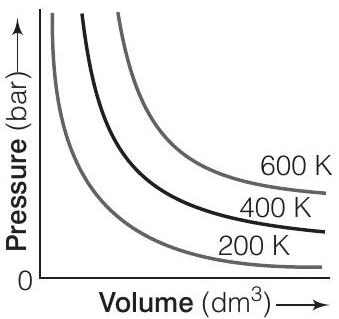
of a gas change if the temperature is increased from $200 \mathrm{~K}$ to $400 \mathrm{~K}$ ?
Answer (i) In accordance to Boyle’s law, pressure of a gas is inversly proportional to its volume if temperature is kept constant. Thus, the volume of a gas will decrease if the pressure on the gas is increased keeping the temperature constant. e.g., at $200 \mathrm{~K}$ when pressure increases from $p_{1}$ to $p_{2}$, volume of the gas decreases, $V_{2}<V_{1}$. (ii) In accordance to Iharles law, volume of a gas is directly proportional to its temperature if pressure is kept constant. Thus, on increasing temperature, the volume of a gas will increase if pressure is kept constant. At constant $p$ when we increase the temperature from $200 \mathrm{~K}$ to $400 \mathrm{~K}$, the volume of the gas increases, $V_{4}>V_{3}$.Show Answer

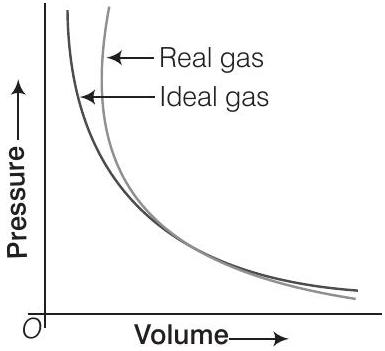
(i) Interpret the behaviour of real gas with respect to ideal gas at low pressure.
(ii) Interpret the behaviour of real gas with respect to ideal gas at high pressure.
(iii) Mark the pressure and volume by drawing a line at the point where real gas hehaves as an ideal qas
Show Answer
Answer
(i) At low pressure, the real gas shows very small deviation from ideal behaviour because the two curves almost coincide at low pressure.
(ii) At high pressure, the real gas show large deviations from ideal behaviour as the curves are far apart.
(iii) At point ’ $A$ ‘, both the curves intersect each other. At this point real gas behaves as an ideal gas. $p_{1}$ and $V_{1}$ are the pressure and volume which corresponds to this point $A$.
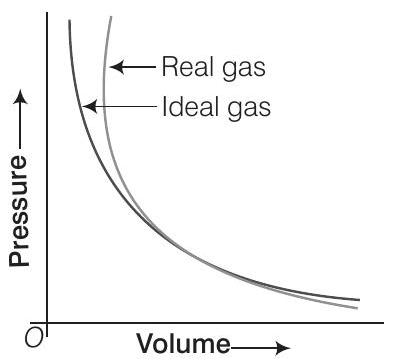
Matching The Columns
41. Match the graphs between the following variables with their names.
| Graphs | Names | |
|---|---|---|
| A.Pressure vs temperature graph at constant molar volume |
1. | Isotherms |
| B.Pressure vs volume graph at constant temperature |
2. | Constant temperature curve |
| C.Volume vs temperature graph at constant pressure |
3. | Isochores |
Answer A. $\rightarrow(3)$ B. $\rightarrow(1)$ C. $\rightarrow(4)$ A. When molar volume is constant, the $p-T$ graph is called isochore. B. When temperature is constant, the $p-V$ graph is called isotherm. C. When pressure is constant, $V-T$ graph is called isobar.Show Answer
| A. | Boyle’s law | 1. | $V \propto n$ at constant $T$ and $p$ |
|---|---|---|---|
| B. | Charle’s law | 2. | $p_{\text {Total }}=p_{1}+p_{2}+p_{3}+\ldots$ at constant $T, V$ |
| C. | Dalton’s law | 3. | $\frac{p V}{T}=$ constant |
| D. | Avogadro’s law | 4. | $V \propto T$ at constant $n$ and $p$ |
| 5. | $p \propto \frac{1}{V}$ at constant $n$ and $T$ |
Answer A. $\rightarrow(5)$ B. $\rightarrow(4)$ C. $\rightarrow(2)$ D. $\rightarrow(1)$ A. Boyle’s law, $p \propto \frac{1}{V}$ at constant $T$ and $n$. B. Charle’s law, $V \propto T$ at constant $p$ and $n$. C. Dalton’s law, $p_{\text {Total }}=p_{1}+p_{2}+p_{3}+\ldots$ at constant $T$, V. D. Avogadro’s law, $V \propto n$ at constant $T$ and $p$.Show Answer

Answer A. $\rightarrow(2)$ B. $\rightarrow(3)$ C. $\rightarrow(1)$ In the following questions a statement of Assertion (A) followed by a statement of Reason ( $R$ ) is given. Choose the correct option out of the choices given below in each question.Show Answer

Assertion and Reason
Reason (R) Intermolecular forces tend to keep the molecules together but thermal energy of molecules tends to keep them apart.
(a) Both $A$ and $R$ are true and $R$ is the correct explanation of $A$
(b) Both $A$ and $R$ are true but $R$ is not the correct explanation of $A$
(c) $A$ is true but $R$ is false
(d) $A$ is false but $R$ is true
Answer (a) Both assertion and reason are true and reason is the correct explanation of assertion. Intermolecular forces and thermal energy decide the state of matter because the former kept the molecules together but later keep them apart.Show Answer
Reason (R) At high pressure all gases have $Z>1$ but at intermediate pressure most gases have $Z<1$.
(a) Both $A$ and $R$ are true and $R$ is the correct explanation of $A$
(b) Both $A$ and $R$ are true but $R$ is not the correct explanation of $A$
(c) $A$ is true but $R$ is false
(d) $A$ is false but $R$ is true
Answer (b) Both assertion and reason are true but reason is not the correct explanation of assertion. At constant temperature, $p V v s V$ for real gases is not a straight line because real gases have intermolecular forces of attraction.Show Answer
Reason (R) At high altitude atmospheric pressure is high.
(a) Both $A$ and $R$ are true and $R$ is the correct explanation of $A$
(b) Both $A$ and $R$ are true but $R$ is not the correct explanation of $A$
(c) $A$ is true but $R$ is false
(d) $A$ is false but $R$ is true
Answer (c) Assertion is true but reason is false. At high altitude, atmospheric pressure is low.Show Answer
Reason (R) Above critical temperature, the molecular speed is high and intermolecular attractions cannot hold the molecules together because they escape because of high speed.
(a) Both $A$ and $R$ are true and $R$ is the correct explanation of $A$
(b) Both $A$ and $R$ are true but $R$ is not the correct explanation of $A$
(c) $A$ is true but $R$ is false
(d) $A$ is false but $R$ is true
Answer (a) Both assertion and reason are true and reason is the correct explanation of assertion. Gases do not liquefy above their critical temperature, even an applying high pressure because above critical temperature, the molecular speed is high and intermolecular attractions cannot hold the molecules together.Show Answer
Reason (R) The density of liquid and gaseous phase is equal to critical temperature.
(a) Both $A$ and $R$ are true and $R$ is the correct explanation of $A$
(b) Both $A$ and $R$ are true but $R$ is not the correct explanation of $A$
(c) $A$ is true but $R$ is false
(d) $A$ is false but $R$ is true
Answer (a) Both assertion and reason are true and reason is the correct explanation of assertion. At critical temperature, density of liquid and gaseous phase becomes equal. Due to which liquid passes into gaseous state imperceptibly and continuously.Show Answer
Reason (R) Small liquid drops have spherical shape.
(a) Both $A$ and $R$ are true and $R$ is the correct explanation of $A$
(b) Both $A$ and $R$ are true but $R$ is not the correct explanation of $A$
(c) $A$ is true but $R$ is false
(d) $A$ is false but $R$ is true
Show Answer
Answer
(d) Assertion is false but reason is true.
Liquid tend to reduce number of molecules or surface tension at there surface, that’s why small liquid drops have spherical shape.
Long Answer Type Questions
50. Isotherms of carbon dioxide at various temperatures are represented in figure. Answer the following questions based on this figure.
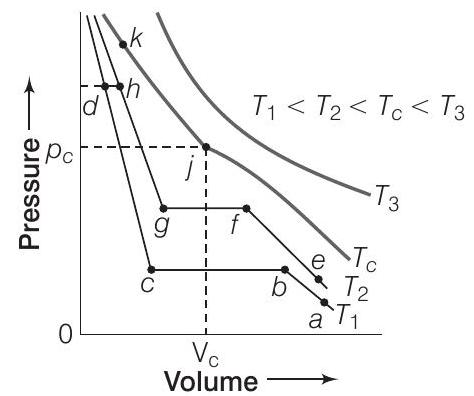
(i) In which state will $CO_{2}$ exist between the points $a$ and $b$ at temperature $T_{1}$ ?
(ii) At what point will $CO_{2}$ start liquefying when temperature is $T_{1}$ ?
(iii) At what point will $CO_{2}$ be completely liquefied when temperature is $T_{2}$ ?
(iv) Will condensation take place when the temperature is $T_{3}$ ?
(v) What portion of the isotherm at $T_{1}$ represent liquid and gaseous $CO_{2}$ at equilibrium?
Answer (i) In gaseous state, $CO_{2}$ will exist between the points $a$ and $b$ at temperature $T_{1}$. (ii) At point $b$, the plot becomes linear, this shows the phase transition, i.e., liquification of $\mathrm{CO}_{2}$ starts and at point $c$, it gets completely liquified. (iii) Similarly, at temperature $T_{2}, g$ is the point at which $\mathrm{CO}_{2}$ will be completely liquified. (iv) Condensation will not take place at $T_{3}$ temperature because $T_{3}>T_{C}$ (critical temperature). (v) Between $b$ and $c$, liquid and gaseous $\mathrm{CO}_{2}$ are in equilibrium.Show Answer
(i) Calculate graphically boiling points of liquids $A$ and $B$.
(ii) If we take liquid $C$ in a closed vessel and heat it continuously. At what temperature will it boil?
(iii) At high altitude, atmospheric pressure is low (say $60 \mathrm{~mm} \mathrm{Hg}$ ). At what temperature liquid $D$ boils?
(iv) Pressure cooker is used for cooking food at hill station. Explain in terms of vapour pressure why is it so?
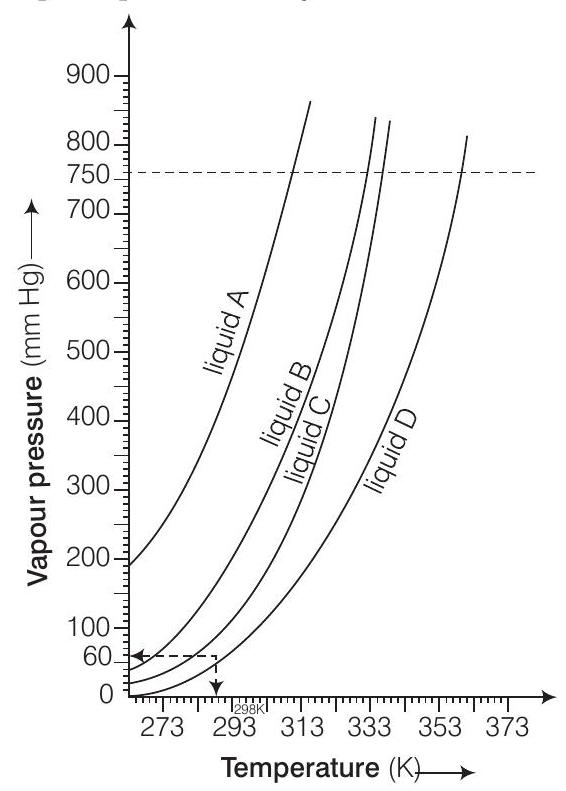
Answer (i) Boiling point of $A=$ approximately $315 \mathrm{~K}$, $B=$ approximately $345 \mathrm{~K}$. (ii) In a closed vessel, liquid $C$ will not boil because pressure inside keeps on increasing (iii) Temperature corresponding to $60 \mathrm{~mm}=313 \mathrm{~K}$. (iv) A liquid boils when vapour pressure becomes equal to the atmospheric pressure. However at high altitudes i.e., on, hills, water boils at low temp erature due to low atmospheric pressure. But when pressure cooker is used, the vapour pressure of water is increased due to which water boils at even lower temperature within a short period of timeShow Answer
Answer In a closed vessel, it is essential to know that below the critical point (i.e., critical temperature and critical pressure), the surface of separation between the liquid and its vapour is clearly visible. As we approach towards the critical point, the density of the liquid decreases while that of the vapour increases due to compression. Below critical point (Meniscus clearly visible) Above critical point (Meniscus disappears) At the critical point, the densities of the liquid and that of the vapour become equal and the surface of separation disappears i.e., the liquid and the gaseous state become not separable. In other words, the meniscus is no longer visible. The fluid which is now a homogeneous mixture is called supercritical fluid. Hence, any fluid above its critical temperature and pressure is called a supercritical fluid. These supercritical fluids dissolve many organic substances. They are used for quick separation of a mixture into its components. e.g., $\mathrm{CO}_{2}$ above $31.1^{\circ} \mathrm{C}$ and above 600 bar pressure has a density of about $1 \mathrm{~g} / \mathrm{cm}^{3}$. It is used to dissolve out caffeine from coffee beans as it is a better substitute than chlorofluorocarbons which are harmful for the environment.Show Answer


Answer Sharp glass edges are heated to make them smooth. Because on heating glass melts and the surface of the liquid tends to take the rounded shape at the edges which has minimum surface area. This is called fire polishing of glass.Show Answer
Show Answer
Answer
When a liquid flows over a fixed surface, the layer of molecules in the immediate contact of surface is stationary. The velocity of the upper layers increases as the distance of layers from the fixed layer increases.
This type of flow in which there is a regular gradation of velocity in passing from one layer to the next is called laminar flow.

In laminar flow, the velocity of molecules is not same in all the layers because every layer offers some resistance or friction to the layer immediately below it.
55. Isotherms of carbon dioxide gas are shown in figure. Mark a path for changing gas into liquid such that only one phase (i.e., either a gas or a liquid) exists at any time during the change. Explain how the temperature, volume and pressure should be changed to carry out the change?
Show Answer
Answer
It is possible to change a gas into a liquid or a liquid into a gas by a process such that there is always a single phase present.
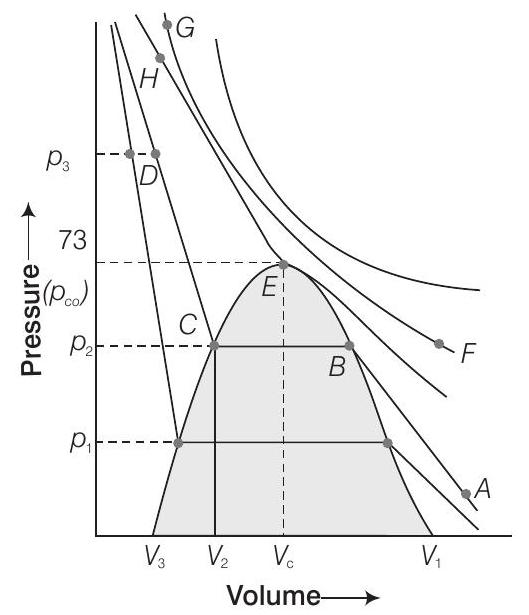
e.g., In figure given above, we can move from $A$ to vertically by increasing the temperature, then we can reach the point by compressing the gas at constant temperature along the isotherm (isotherm at $31.1^{\circ} \mathrm{C}$ ). The pressure will increase.
Now, we can move vertically down towards $D$ by lowering the temperature. As soon as we cross the point $\mathrm{H}$ on the critical isotherm, we get liquid. Thus, at no stage during the process, we can through two-phase region.
It process is carried out at the critical temperature, substance always remains in one phase. This is called continuity of state between the gaseous and the liquid state.










